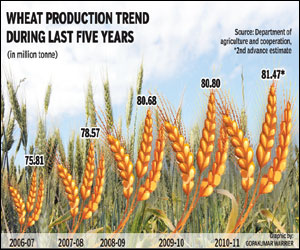The country is all set to harvest a record wheat output in the current rabi season due to favourable weather conditions prevailing during the last few months and prompt measures to control the yellow rust disease which had threatened to destroy wheat crop in parts of Jammu and Kashmir and Punjab.
The government has set a record wheat production target of 81.47 million tonnes in 2010-11 against 80.8 million tonnes in the previous year.
 Farmers are expected to commence wheat harvesting in next few days in Madhya Pradesh and in a week’s time in eastern India. Harvesting is to start in Punjab and Haryana during the first week of April.
Farmers are expected to commence wheat harvesting in next few days in Madhya Pradesh and in a week’s time in eastern India. Harvesting is to start in Punjab and Haryana during the first week of April.
?Due to measures taken by the state government in curbing the yellow rust disease from spreading and prolonged winter months, the wheat crop is in good condition and there is no cause of worry at this point of time,? SS Singh, director of Karnal-based Directorate of Wheat Research (DWR), a body under the Indian Council of Agricultural Research, told FE.
According to the latest government data, wheat has been sown in 29.4 million hectares, 1 million hectares more than last year.
Earlier in the month, Punjab Agricultural University (PAU) had warned of severe damage to wheat yield if yellow rust disease was not controlled at the earliest. A field survey carried out by PAU found the appearance of yellow rust disease in the sub-mountainous areas including Ropar, Hoshiarpur, and Gurdaspur districts.
?The government agencies in collaboration with farmers carried out massive spraying of fungicide in the yellow rust-affected crop, which prevented the disease from spreading,? DWR’s Singh said.
The dreaded Ug99 fungus, commonly known as yellow rust, had already destroyed large swathes of wheat crop in Kenya, Uganda, Ethiopia, Yemen, Sudan and Iran, and had become a real danger for the Indian wheat crop. Scientists and experts felt that sooner or later this dreaded disease was bound to impact Indian crops.
However, to the credit of Indian scientist, Ug99 has been successfully restricted. As many 22 wheat lines or varieties such as PBW550, DBW17, LOK1, etc, developed by DWR and other state agencies have been found to be resistant to Ug99.
India’s rising wheat production in the last few years had largely been attributed to favourable weather and significant rise in the minimum support price, but a big factor also has been the virtual absence of any threatening crop disease, particularly yellow rust.

